LG Electronics USA V134MEA Microwave Oven User Manual
LG Electronics USA Microwave Oven Users Manual
Users Manual
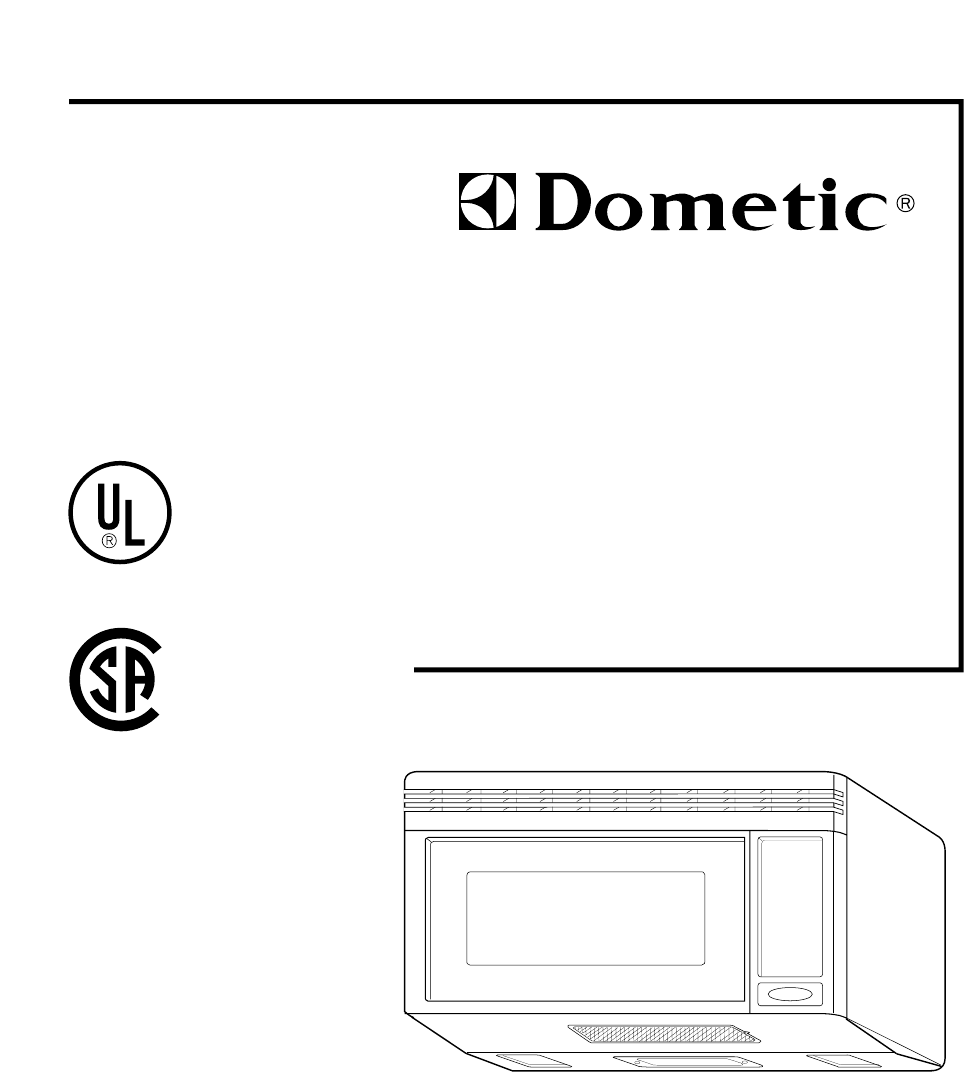
LISTED
LISTED
MODEL NO.: DOTR12CW, DOTR12CB
To help you get the
most out of your
new appliance
P/N: 3828W5A1427
OVER THE RANGE
MICROWAVE OVEN
OWNER’S
GUIDE

- 2 -
(a) Do not attempt to operate this oven with
the door open since open-door operation
can result in harmful exposure to
microwave energy. It is important not to
defeat or tamper with the safety
interlocks.
(b) Do not place any object between the
oven front face and the door or allow soil
or cleaner residue to accumulate on
sealing surfaces.
(c) Do not operate the oven if it is damaged.
It is particularly important that the oven
door closes properly and that there is no
damage to the:
(1) Door (bent),
(2) Hinges and latches (broken or
loosened),
(3) Door seals and sealing surfaces.
(d) The oven should not be adjusted or
repaired by anyone except properly
qualified service personnel.
PRECAUTIONS TO AVOID POSSIBLE
EXPOSURE TO EXCESSIVE
MICROWAVE ENERGY...

- 3 -
TABLE OF CONTENTS
PRECAUTIONS TO AVOID POSSIBLE
EXPOSURE TO EXCESSIVE MICROWAVE
ENERGY...............................................................
TABLE OF CONTENTS .......................................
SAFETY................................................................
Important Safety Instructions ............................
INFORMATION.....................................................
Location of Model Number.................................
Oven Specifications ...........................................
Electrical Rating.................................................
Electrical Requirements.....................................
Grounding Instructions.......................................
Microwave Oven Features.................................
Oven Control Panel ...........................................
OPERATION.........................................................
Learn About Your Microwave Oven...................
Clock..................................................................
Custom Select....................................................
Light On/Of ........................................................
Vent On/Off........................................................
Child Lock ..........................................................
ADD 30 ..............................................................
Cooking at High Cook Power.............................
More/Less ..........................................................
Cooking at Lower Power Levels ........................
Popcorn..............................................................
Potato ...............................................................
Beverage ..........................................................
Frozen Entree...................................................
Fresh Vegetable ...............................................
Cooking Guide for Lower Power Levels ...........
Auto Cook Chart ...............................................
Auto Defrost......................................................
Auto Defrosting Tips .........................................
Auto Defrost Chart............................................
COOKING............................................................
Getting the Best Cooking Results.....................
Fish & Shellfish.................................................
Appetizers/Sauces/Soups.................................
Meat..................................................................
Poultry...............................................................
Pasta and Rice .................................................
MAINTENANCE ..................................................
Care And Cleaning ...........................................
Cleaning the Grease Filters..............................
Charcoal Filter Replacement ............................
Cooktop Light Replacement .............................
Microwave Utensil Guide..................................
TROUBLE SHOOTING .......................................
Before Calling For Service................................
Questions and Answers....................................
WARRANTY ...............................Inside back cover
2
3
4
4
6
6
6
6
6
6
7
8
10
10
10
10
10
10
10
11
11
11
11
11
12
12
12
12
13
14
15
15
16
18
18
18
19
19
21
22
23
23
23
23
23
24
25
25
25

- 4 -
WARNING-To reduce the risk of burns, electric
shock, fire, injury to persons, or exposure to
excessive microwave energy.
• Read all the instructions before using your oven.
• Do not allow children to use this oven without
close supervision.
• Read and follow the specific PRECAUTIONS TO
AVOID POSSIBLE EXPOSURE TO
EXCESSIVE MICROWAVE ENERGY found
on page 2.
• Do not use corrosive chemicals or vapors, such as
sulfide and chloride, in this appliance. This type of
oven is specifically designed to heat, cook, or dry
food. It is not designed for industrial or laboratory
use.
• Do not use or store this appliance outdoors. Do not
use this product near water -for example, near a
kitchen sink, in a wet basement, or near a swimming
pool, and the like.
• Do not use the cavity for storage purposes. Do not
leave paper products, cooking utensils, or food in
the cavity when not in use.
• Clean the ventilating hood frequently. Do not
allow grease to accumulate on the hood or the
filters.
• Use carefully when cleaning the vent hood filters.
Corrosive cleaning agents such as lye-based oven
cleaners, may damage the filters.
• Do not tamper with the built-in safety switches
on the oven door. The oven has several built-in
safety switches to make sure the power is off when
the door is open.
• When food flames under the hood, turn the fan on.
• Suitable for use above gas or electric cooking
equipment 22 inches or less wide.
• Do not use this oven for commercial purposes. It
is made for household use only.
• When cleaning the door and the surfaces that
touch the door, use only mild, non-abrasive
soaps or detergents and a sponge or soft cloth.
• If your oven is dropped or damaged, have it
thoroughly checked by a qualified service technician
before using it again.
• To avoid a fire hazard:
- Do not severely overcook food. Severely
overcooked foods can start a fire in the oven.
Watch the oven carefully, especially if you have
paper, plastic, or other combustibles in the oven.
- Do not store combustible items (bread,
cookies, etc.) in the oven, because if lightning
strikes the power lines it may cause the oven to
turn on.
- Do not use wire twist-ties in the oven. Be sure
to inspect purchased items for wire twist-ties and
remove them before placing the item in the oven.
• If a fire should start:
- Keep the oven door closed.
- Turn the oven off.
- Disconnect the power cord or shut off the
power at the fuse or circuit breaker panel.
• To avoid electric shock:
- This appliance must be grounded. Connect it
only to a properly grounded outlet. See the
electrical GROUNDING INSTRUCTIONS
on page 6.
- Do not operate this appliance if it has a
damaged cord or plug, if it is not working
properly or if it has been damaged or dropped.
- Do not immerse the electrical cord or plug in
water.
- Keep the cord away from heated surfaces.
IMPORTANT SAFETY INSTRUCTIONS
The safety instructions below will tell you how to use your oven and avoid harm to yourself or
damage to your oven.
SAFETY

- 5 -
• To avoid improperly cooking some foods.
- Do not heat any types of baby bottles or baby
food. Uneven heating may occur and possibly
cause personal injury.
- Do not heat small-necked containers, such as
syrup bottles.
- Do not deep-fat fry in your microwave oven.
- Do not attempt home canning in your
microwave oven.
- Do not heat the following items in the
microwave oven: whole eggs in the shell, water
with oil or fat, sealed containers, or closed glass
jars. These items may explode.
• Do not cover or block any openings in the oven.
• Use your oven only for the operations described in
this manual.
• Do not run the oven empty, without food in it.
• Do not let cord hang over edge of table or counter.
• Preserve the oven floor:
- Do not heat the oven floor excessively.
- Do not allow the gray film on special microwave-
cooking packages to touch the oven floor. Put the
package on a microwavable dish.
- Do not cook anything directly on the oven floor or
turntable. Use a microwavable dish.
- Keep a browning dish at least 3/16 inch above floor.
Carefully read and follow the instructions for the
browning dish. If you use a browning dish
incorrectly, you could damage the oven floor.
• Install or locate this appliance only in accordance
with the provided installation instructions.
• This appliance should be serviced only by qualified
service personnel. Contact the nearest authorized
service facility for examination, repair, or adjustment.
SAVE THESE INSTRUCTIONS
WARNING:
This equipment generates and uses ISM frequency
energy and if not installed and used properly, that is
in strict accordance with the manufacturer's
instructions, may cause interference to radio and
television reception. It has been type tested and
found to comply with limits for ISM Equipment
pursuant to part 18 of FCC Rules, which are
designed to provide reasonable protection against
such interference in a residential installation.
However, there is no guarantee that interference will
not occur in a particular installation. If this equipment
does cause interference to radio or television
reception, which can be determined by turning the
equipment off and on, the user is encouraged to try
to correct the interference by one or more of the
following:
• Reorient the receiving antenna of the radio or
television.
• Relocate the Microwave Oven with respect to the
receiver.
• Move the microwave oven away from the receiver.
• Plug the microwave oven into a different outlet so
that the microwave oven and the receiver are on
different branch circuits.
The manufacturer is not responsible for any radio or
TV interference caused by unauthorized
modification to this microwave oven. It is the
responsibility of the user to correct such interference.
FEDERAL COMMUNICATIONS COMMISSION RADIO FREQUENCY
INTERFERENCE STATEMENT ( U.S.A. ONLY)
SAFETY
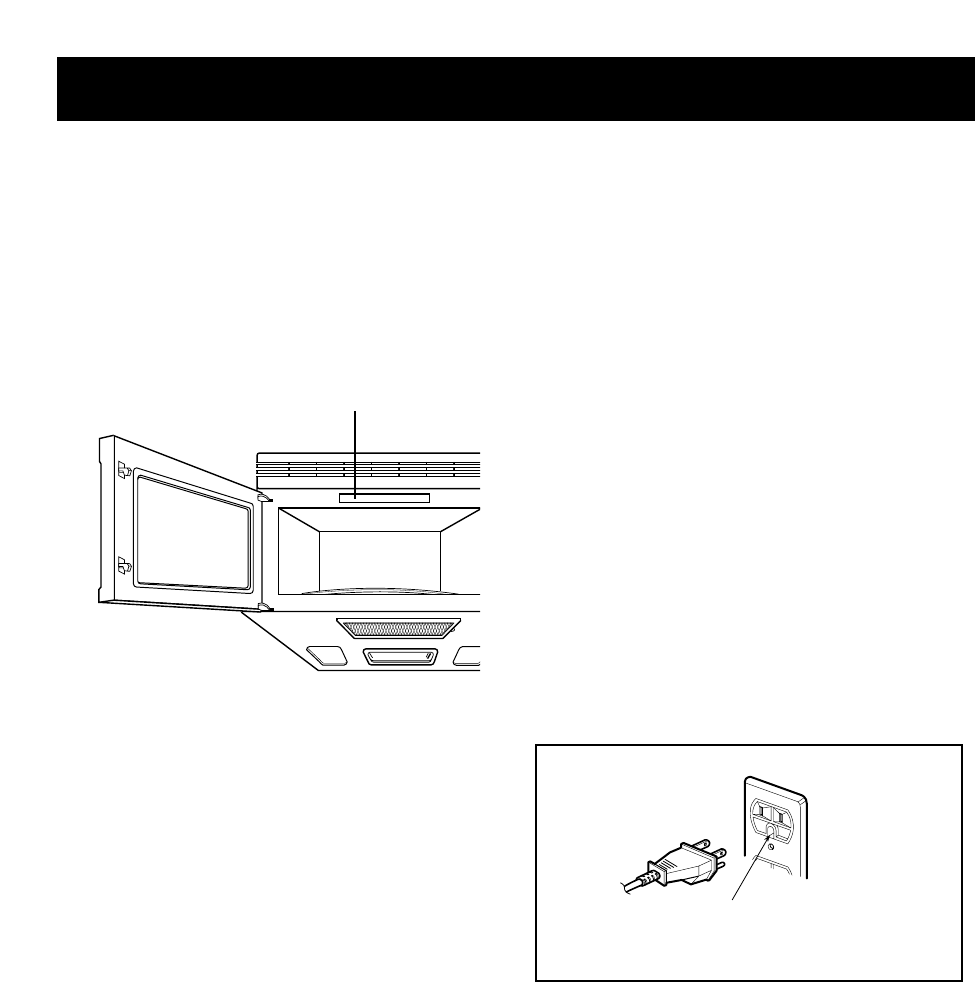
- 6 -
Please read this owner’s manual. It will tell you how
to use all the fine features of this microwave oven.
LOCATION OF MODEL NUMBER
To request service information or replacement parts,
the service center will require the complete model
number of your microwave oven. The number is on the
oven front as shown in the illustration below.
OVEN SPECIFICATIONS
Output Power 950W (IEC 705 Standard)
Outer Dimensions 217/8" x 161/8" x 165/8" (W x H x D)
Cavity Volume 1.3 Cu.ft
Net Weight 48 lbs.
Ventilation Capacity 130 CFM
ELECTRICAL RATING
* Electrical Rating of the Oven:120V AC, 60Hz
* 12.5 A / 1350 W ( MWO + Cooktop Lamp +
Ventilation Fan)
ELECTRICAL REQUIREMENTS
The oven is designed to operate on a Standard
120V/60 Hz household outlet. Be sure the circuit is at
least 15A and the microwave oven is the only
appliance on the circuit. It is not designed for 50Hz or
any circuit other than a 120V/60Hz circuit.
GROUNDING INSTRUCTIONS
This appliance must be grounded. If an electrical
short circuit occurs, grounding reduces the risk of
electric shock by providing an escape wire for the
electric current. The cord for this appliance has a
grounding wire with a grounding plug. Put the plug into
an outlet that is properly installed and grounded.
WARNING - If you use the grounding plug
improperly, you risk electric shock.
Ask a qualified electrician if you do not understand the
grounding instructions or if you wonder whether the
appliance is properly grounded.
Because this appliance fits under the cabinet, it has a
short power-supply cord. See the separate Installation
Instructions for directions on placing the cord properly.
Keep the electrical power cord dry and do not pinch or
crush it in any way.
If it is necessary to use an extension cord, use only a
3-wire extension cord that has a 3-blade grounding
plug, and a 3-slot receptacle that will accept the plug
on the appliance. The marked rating of the extension
cord shall be equal to or greater than the electrical
rating of the appliance.
For a permanently connected appliance:
This appliance must be connected to a grounded,
metallic, permanent wiring system, or an equipment
grounding conductor should be run with the circuit
conductors and connected to the equipment grounding
terminal or lead on the appliance.
Ensure proper ground
exists before use
MODEL NUMBER LABEL
INFORMATION
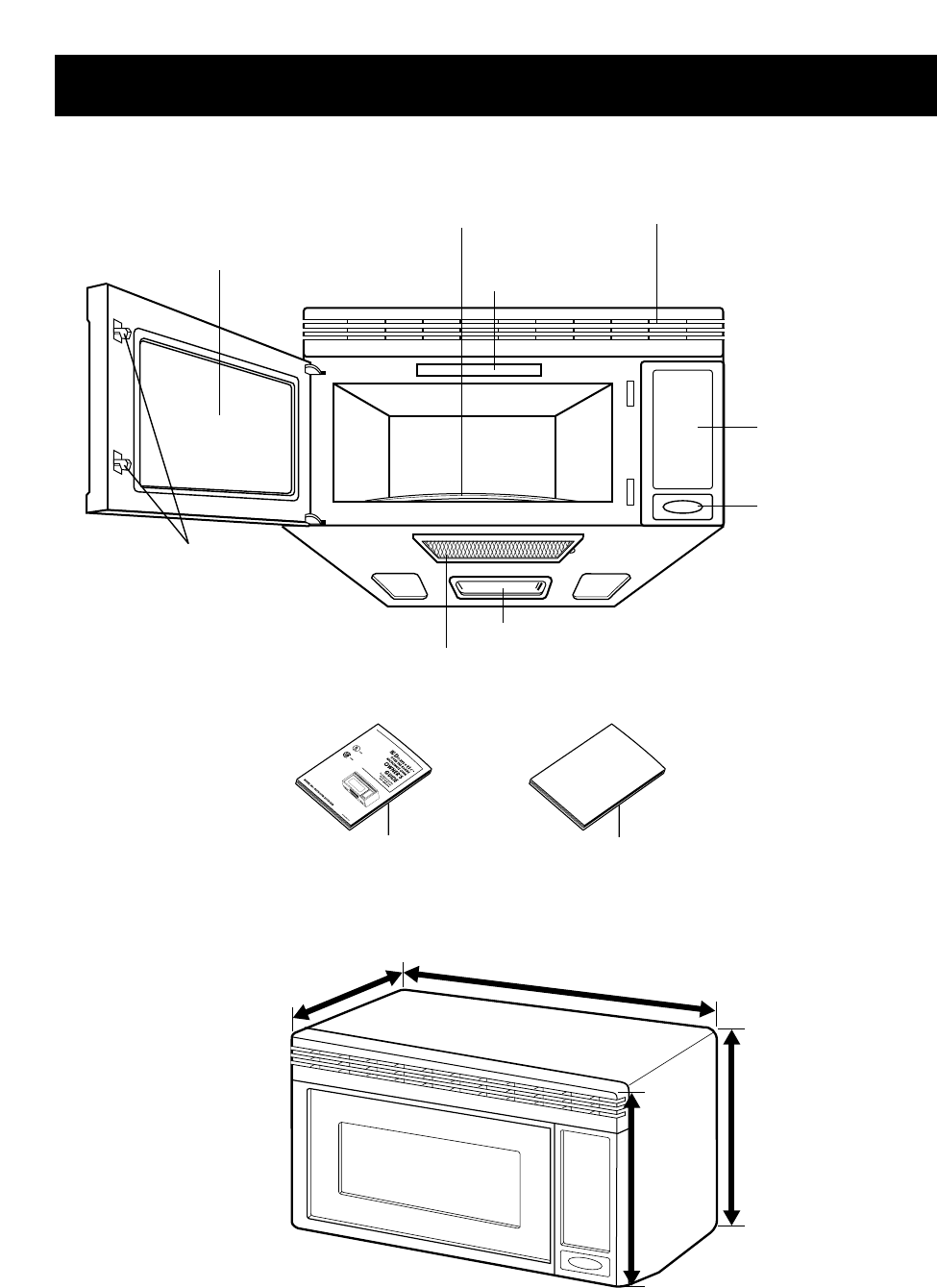
- 7 -
MICROWAVE OVEN FEATURES
Cooktop/Countertop Light
Grease Filter
Door Safety
Lock System
Window with
Metal Shield
Glass Turntable
Model and Serial
Number Plate
Vent Grille
Oven Control
Panel
Owner's
Guide
Door Open
Button
Installation
Manual
217/8"
165/8"
153/8"
161/8"
INFORMATION
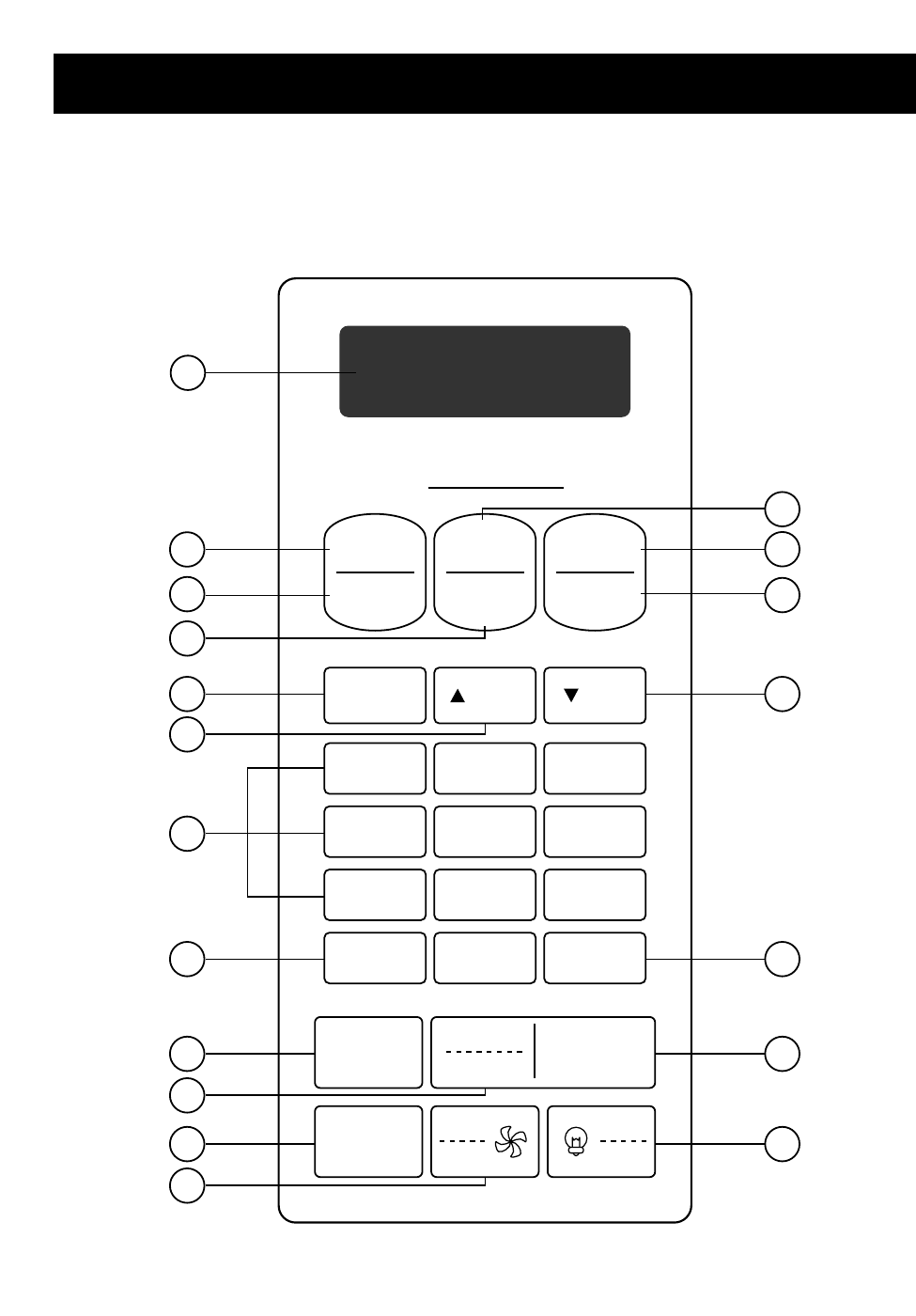
- 8 -
OVEN CONTROL PANEL
POPCORN
ADD 30
AUTO COOK
AUTO
DEFROST
POTATO
FROZEN
ENTREE FRESH
VEGETABLE
BEVERAGE
MORE LESS
CLOCK STOP
CLEAR
START
CUSTOM
SELECT
VENT
On/Off
LIGHT
On/Off
123
456
789
POWER
LEVEL 0COOK
TIME
1
2
8
11
9
15
6
4
3
7
10
12 13
14 16
18
17 19
5
INFORMATION

- 9 -
INFORMATION
1. DISPLAY: The display includes a clock and
indicators to tell you time of day, cooking time
settings, and cooking functions selected.
2. POPCORN: Touch this pad when popping popcorn
in your microwave oven. See page 11 for more
information.
3. POTATO: Touch this pad to cook from 1 to 4
potatoes. See page 12 for more information.
4. BEVERAGE: Touch this pad to reheat one or two
cups of a beverage. See page 12 for more
information.
5. AUTO DEFROST: Meat, poultry, fish. Touch on pad
to select food type and defrost food by weight.
See page 15 for more information.
6. FROZEN ENTREE: Touch this pad to reheat 10 oz.
See page 12 for more information.
7. FRESH VEGETABLE: Touch this pad to cook from
1 to 4 cups. See page 12 for more information.
8. ADD 30: Touch this pad to start microwave oven
without touching START. You can set 30 seconds up
to 3 minutes; after 3 minutes, every touch will add 1
minute up to 99 min. 59 sec. See page 11 for more
information.
9. MORE: Touch this pad to add ten seconds of
cooking time each time you press it.
10. LESS: Touch this pad to subtract ten seconds of
cooking time each time you press it.
11. NUMBER: Touch number pads to enter cooking
time, power level, quantities, or weights.
12. POWER LEVEL: Touch this pad to select a
cooking power level.
13. COOK TIME: Used to set manual time cooking.
14. CLOCK: Touch this pad to enter the time of day.
See page 10 for more information.
15. STOP/CLEAR: Touch this pad to stop the oven or
to clear all entries.
16. START: Touch this pad to start a function. If you
open the door after oven begins to cook, touch
START again.
17. CUSTOM SELECT: Touch this pad to change the
oven’s default settings for sound, clock, display
scroll speed, defrost weight.
See page 10 for more information.
18.VENT ON/OFF: Touch this pad to turn the fan on or
off. See page 10 for more information.
19. LIGHT ON/OFF: Touch this pad to turn on the
cooktop/countertop light. See page 10 for more
information.
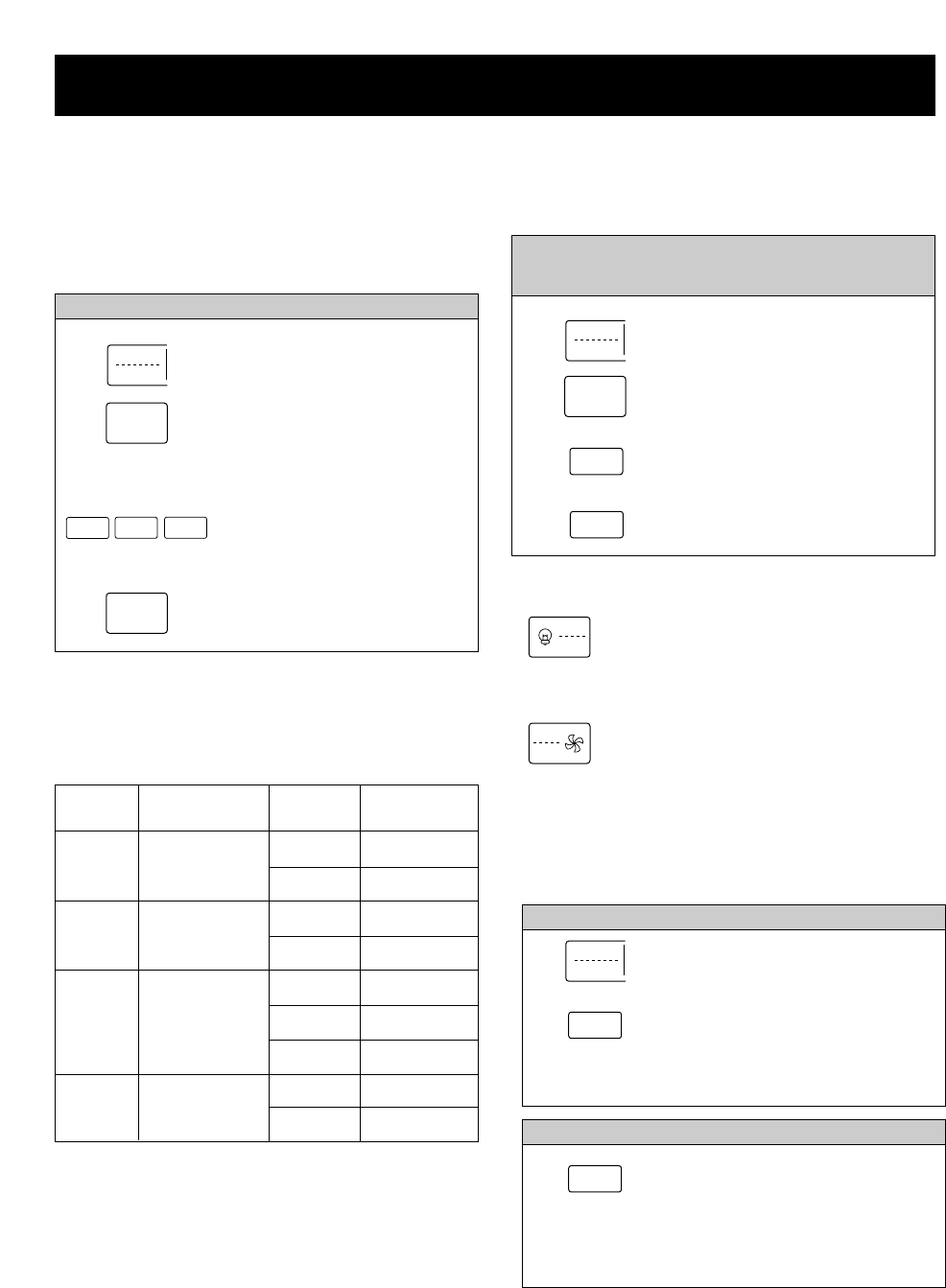
- 10 -
CHILD LOCK
You may lock the control panel to prevent the
microwave
from being accidentally started or used by children.
1. Touch STOP/CLEAR.
2. Touch and hold 0more than
4 seconds. LOCKED will appear
in the display window with two
beeps.
Example: To set the child lock.
1. Touch and hold 0more than
4 seconds. LOCKED will
disappear and you hear two
beeps. At this time the oven is
ready.
Example: To cancel the child lock.
VENT ON/OFF
The fan moves steam and other vapors
from the surface cooking. Touch VENT
once for High fan speed, twice to turn the
fan off.
LEARN ABOUT YOUR MICROWAVE OVEN
This section discusses the concepts behind microwave cooking and introduces you to the basics you need to
know to operate your microwave oven. Please read this information before use.
CLOCK (TIME OF DAY)
This oven includes a 12-hour clock.
OPERATION
1. Touch STOP/CLEAR.
2. Touch CLOCK.
(Press once for AM,
twice for PM.)
3. Enter the time by using the
number key pad.
4. Touch CLOCK.
Example: To set 8:00 AM.
STOP
CLEAR
STOP
CLEAR
CLOCK
CLOCK
8!0!0!
CUSTOM SELECT
You can change the default values for beep sound,
clock, display scroll speed, defrost weight.
See the following chart for more information.
NUMBER
11
2
1
2
1
2
3
1
2
2
Beep ON/OFF
control
Sound ON
Sound OFF
Clock ON
Clock OFF
Slow speed
Normal speed
Fast speed
Lbs.
Kg.
Clock display
control
Display
Defrost weight
mode select
3
4
FUNCTION RESULT
1. Touch STOP/CLEAR.
2. Touch CUSTOM SELECT.
3. Touch number 4.
4. Touch number 2.
Example: To change defrost weight mode.
(from Lbs. to Kg.)
NUMBER
LIGHT ON/OFF
Touch LIGHT once for light, or twice
to turn the light off.
LIGHT
On/Off
4!
2!
STOP
CLEAR
0!
0!
CUSTOM
SELECT
VENT
On/Off
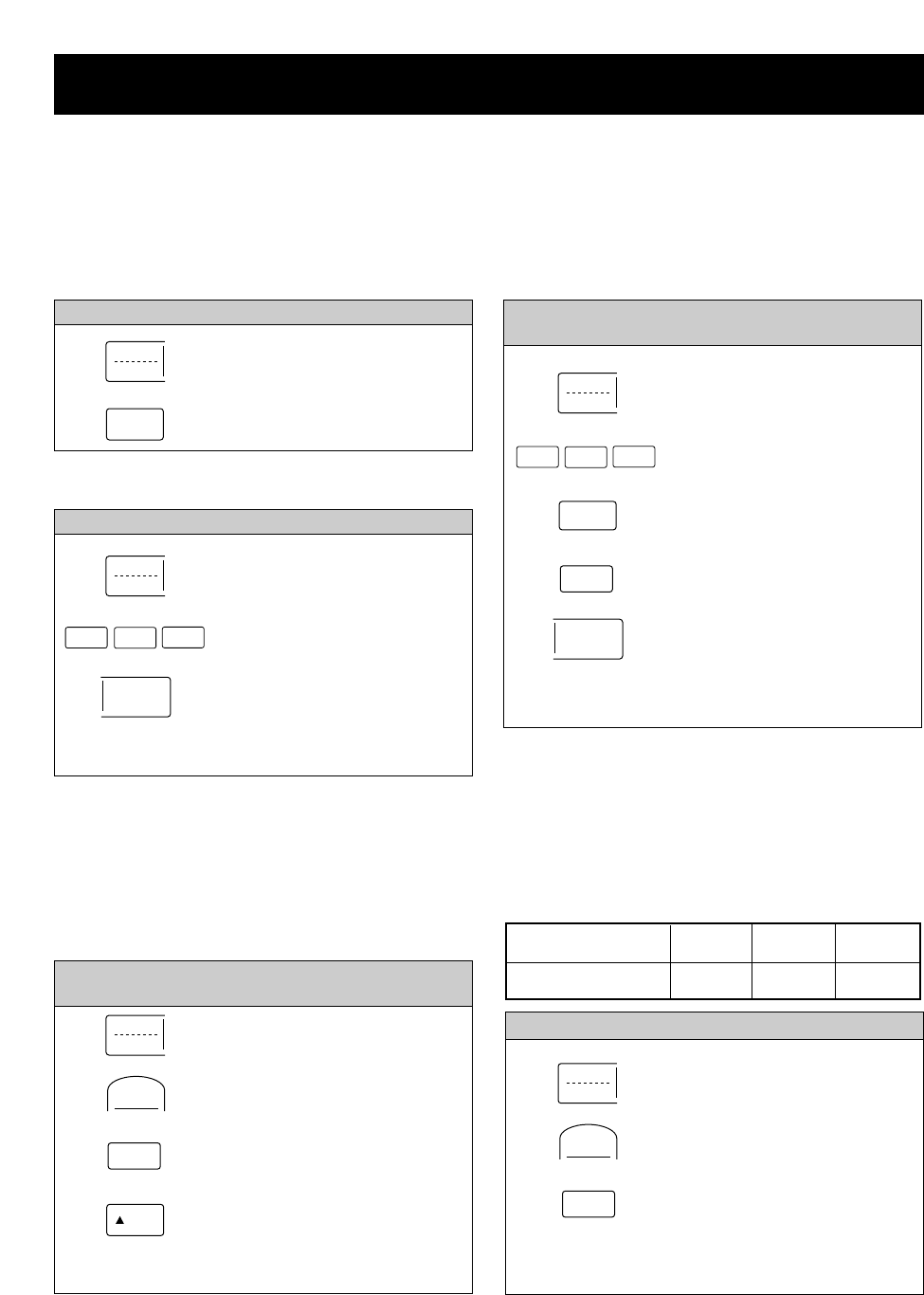
- 11 -
OPERATION
ADD 30
A time-saving pad, this simplified control lets you
quickly set and start microwave cooking without the
need to touch START.
If you touch ADD 30, it will add 30 seconds up to 3
minutes; after 3 minutes, every touch will add 1 minute
up to 99 min. 59 sec.
1. Touch STOP/CLEAR.
2. Touch ADD 30 four times.
Example: To cook for 2 minutes.
COOKING AT HIGH COOK POWER
1. Touch STOP/CLEAR.
2. Enter the cook time.
3. Touch START.
When the cook time is over,
you will hear three beeps and
END will display.
Example: To cook food for 8 minutes 30 seconds.
8!3!0!
STOP
CLEAR
ADD 30
STOP
CLEAR
START
1. Touch STOP/CLEAR.
2. Enter the cook time.
3. Touch POWER LEVEL.
4. Enter the power level.
5. Touch START.
When the cook time is over,
you will hear three beeps and
END will display.
Example: To cook food for 7 minutes 30 seconds
at 70% power.
COOKING AT LOWER POWER
LEVELS
HIGH power cooking does not always give you the
best results with foods that need slower cooking, such
as roasts, baked goods, or custards. Your oven has
9 power settings in addition to HIGH.
MORE/LESS
By using the MORE or LESS keys, all of the AUTO
COOK and TIME COOK program can be adjusted to
cook food for a longer or shorter time.
Pressing MORE will add 10 seconds of the cooking time
each time you press it. Pressing LESS will subtract 10
seconds of cooking time each time you
press it.
1. Touch STOP/CLEAR.
2. Touch POPCORN.
3. Touch 1.
4. Touch MORE.
Example: To adjust the 1.75 oz POPCORN cooking
time for a longer time.
NOTE: Press the MORE or LESS
key during time countdown.
7!
3!
0!
STOP
CLEAR
STOP
CLEAR
POWER
LEVEL
POPCORN
MORE
START
1!
7!
POPCORN
Popcorn lets you pop 1.75, 3.0, and 3.5 ounce bags of
commercially packaged microwave popcorn. Pop only
one package at a time. If you are using a microwave
popcorn popper, follow manufacturer’s instructions.
To set your microwave oven correctly, follow this
chart:
Bag Size-ounces
Touch NUMBER
1.75
123
3.0 3.5
1. Touch STOP/CLEAR.
2. Touch POPCORN.
3. Touch number 2.
When the cook time is over,
you will hear three beeps and
END will display.
Example: To pop a 3.0 oz. bag.
STOP
CLEAR
POPCORN
2!
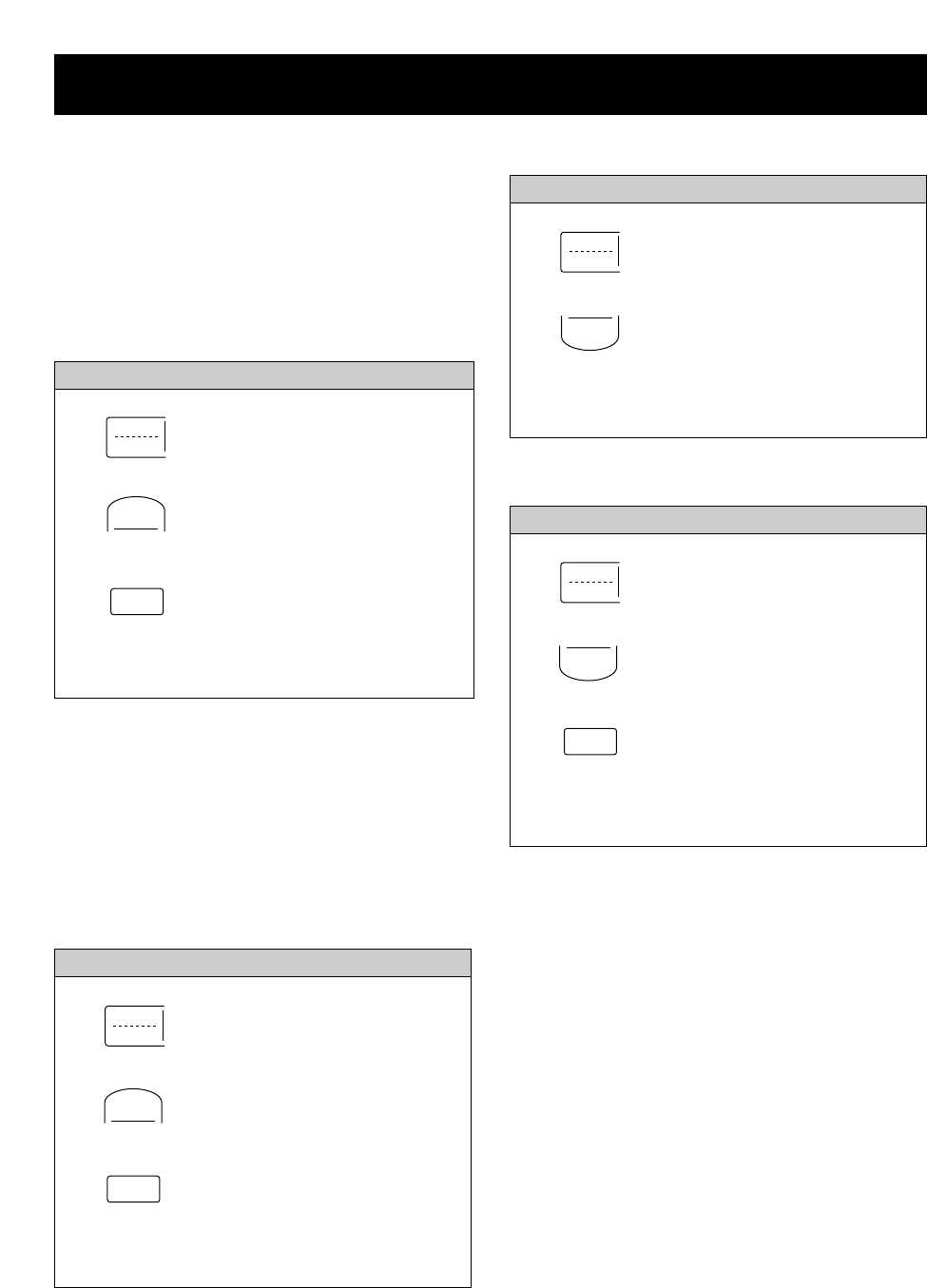
- 12 -
OPERATION
POTATO
The POTATO pad lets you cook potatoes with preset
times and cook powers. You can choose from
1 to 4 potatoes.
NOTE:
• Cooking times are based on an average 8 ounce
potato.
• Before baking, pierce potato with fork several times.
• After baking, let stand for 5 minutes.
1. Touch STOP/CLEAR.
2. Touch POTATO.
3. Touch number 2.
When the cook time is over,
you will hear three beeps and
END will display.
Example: To cook 2 Potatoes.
STOP
CLEAR
POTATO
2!
FROZEN ENTREE
1. Touch STOP/CLEAR.
2. Touch FROZEN ENTREE.
When the cook time is over,
you will hear three beeps and
END will display.
Example: To reheat 10 oz.
STOP
CLEAR
FROZEN
ENTREE
FRESH VEGETABLE
1. Touch STOP/CLEAR.
2. Touch FRESH VEGETABLE.
3. Touch number 4.
When the cook time is over,
you will hear three beeps and
END will display.
Example: To cook 4 cups.
FRESH
VEGETABLE
4!
BEVERAGE
BEVERAGE lets you heat up to 2 beverages.
NOTE:
• Reheat times based on an 8 ounce cup.
• Beverage heated with the beverage feature may be
very hot.
• Remove the container with care.
• Beverage may be very hot; remove from oven with
care.
1. Touch STOP/CLEAR.
2. Touch BEVERAGE.
3. Touch number 1.
When the cook time is over,
you will hear three beeps and
END will display.
Example: To reheat one 8 oz. beverage.
STOP
CLEAR
BEVERAGE
1!
STOP
CLEAR
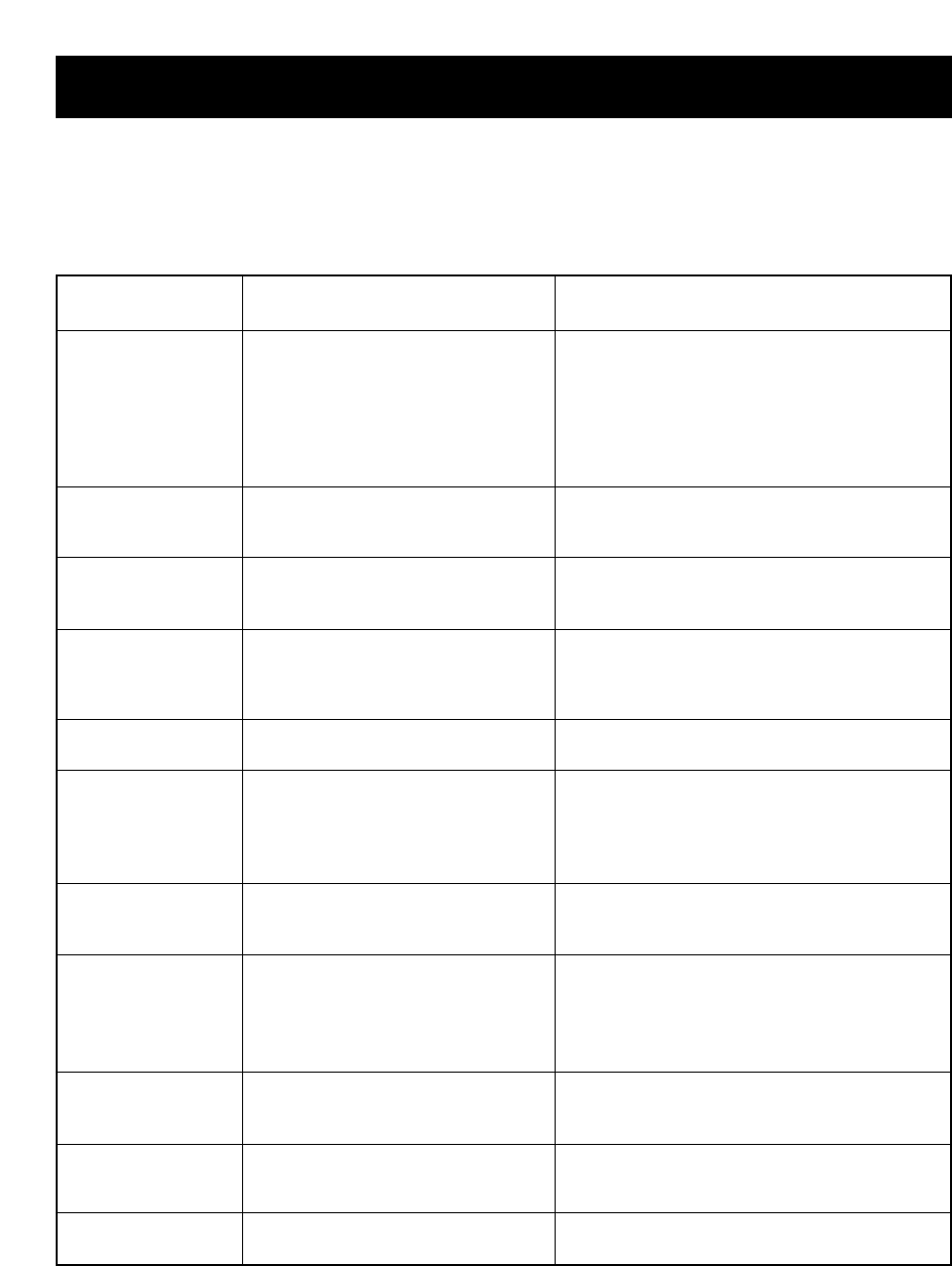
- 13 -
OPERATION
POWER LEVEL MICROWAVE OUTPUT USE
• Boil water.
• Cook ground beef.
• Make candy.
• Cook fresh fruits and vegetables.
• Cook fish and poultry.
• Preheat browning dish.
• Reheat meat slices quickly.
• Saute onions, celery, and green pepper.
• All reheating.
• Cook scrambled eggs.
• Cook breads and cereal products.
• Cook cheese dishes, veal.
• Cook cakes, muffins, brownies, cupcakes.
• Cook pasta.
• Cook meats, whole poultry.
• Cook custard.
• Cook whole chicken, turkey, spare ribs, rib
roast, sirloin roast.
• Cook less tender cuts of meat.
• Reheat frozen convenience foods.
• Thawing meat, poultry, and seafood.
• Cooking small quantities of food.
• Finish cooking casserole, stew, and some
sauces.
• Soften butter and cream cheese.
• Heating small amounts of food.
• Soften ice cream.
• Raise yeast dough.
• Standing time.
10
HIGH
9
8
7
6
5
4
3
2
1
0
100%
90%
80%
70%
60%
50%
40%
30%
20%
10%
COOKING GUIDE FOR LOWER POWER LEVELS
The nine power levels in addition to HIGH allow you to
choose the best power level for the food you are
cooking. Below are listed all the power levels,
examples of foods best cooked at each level, and the
amount of microwave power you are using.
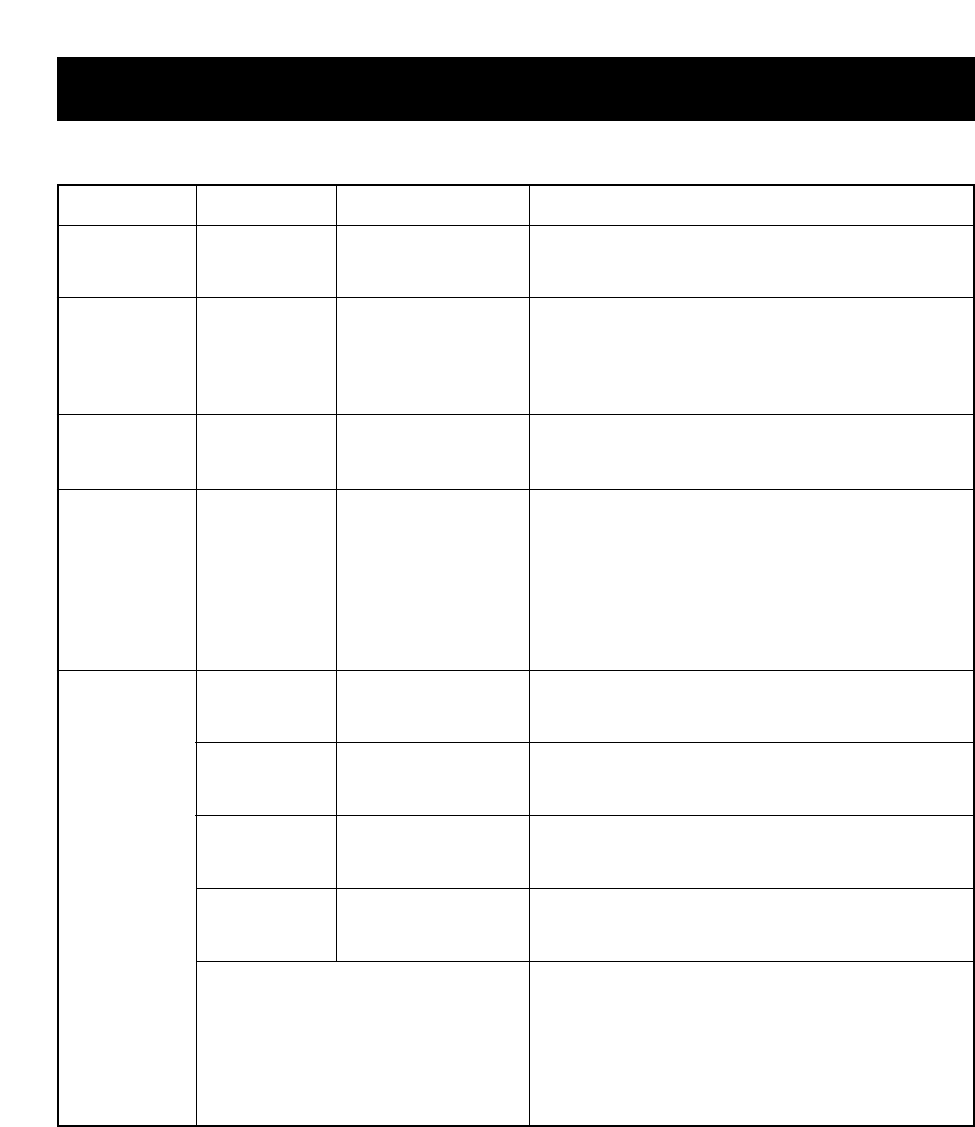
- 14 -
OPERATION
AUTO COOK CHART
CATEGORY QUANTITY
DIRECTIONS
POPCORN
BEVERAGE
FROZEN
ENTREE
FRESH
VEGETABLE
POTATO
SERVINGS
Place back on turntable.
Follow manufacture’s instructions.
Wash and scrub well.
Pierce with fork.
Place on microproof rack or paper towel in
a circle (1"-2.5cm), apart.
Let stand 3 to 5 minutes after cooking.
No cover.
Use uncovered microproof cup(s) or mug(s).
Stir after reheating.
Remove package from wrapper.
Follow 1 package instructions for
microwaving.
Place entree on a microwave plate.
Cover tightly with wax paper.
Examples of one frozen dinner are Lasagna
with Meat Sauce, Chicken with Rice and
Sliced Turkey Breast with Rice.
Cover with microwave safe, plastic wrap.
Cover with microwave safe, plastic wrap.
Cover with microwave safe, plastic wrap.
Cover with microwave safe, plastic wrap.
Prepare vegetable(wash, cut-up vegetables
into 1/2-inch(1"-2.5cm) slices or pieces.).
Place in microproof bowl or casserole.
Add water. Cover. Most vegetables profit from
2 to 3 minutes standing time after cooking.
Note: Fresh vegetable weight is given after
peeling, trimming, slicing, etc.
1.75 oz. (50g)
3.0 oz. (85g)
3.5 oz. (100g)
8 oz. (227g)
16 oz. (454g)
24 oz. (680g)
32 oz. (907g)
1 cup (8 oz.-227mL)
2 cups (16 oz.-454mL)
10 oz. (283g)
8 oz. (227g)
Vegetables and
2 tbsp water
16 oz. (454g)
Vegetables and
1/4cup water
24 oz. (680g)
Vegetables and
1/3cup water
32 oz. (907g)
Vegetables and
1/2cup water
1 serving
2 servings
3 servings
4 servings
Coffee/Tea
(Refrigerated
Temp.)
1 serving
1 cup
2 cups
3 cups
4 cups
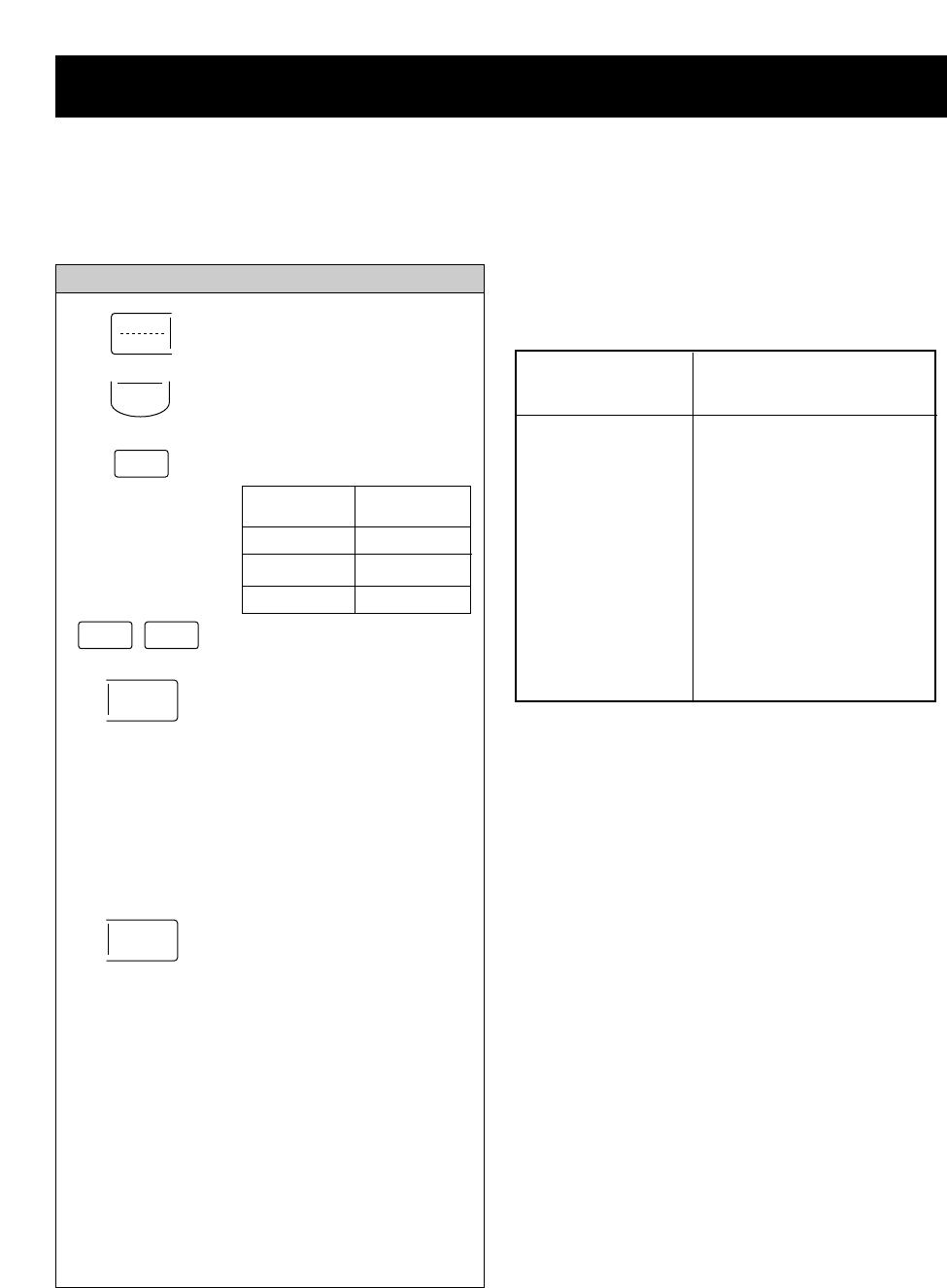
- 15 -
OPERATION
Weight conversion chart
You are probably used to food weights being in pounds
and ounces that are fractions of a pound (for example
4 ounces equals 1/4 pound).
However, in order to enter food weight in AUTO
DEFROST, you must specify pounds and tenths of a
pound. If the weight on the food package is in fractions
of a pound, you can use the following chart to convert
the weight to decimals.
AUTO DEFROSTING TIPS
• When using AUTO DEFROST, the weight to be
entered is the net weight in pounds and tenths of
pounds (the weight of the food minus the container).
• Use AUTO DEFROST only for raw food. AUTO
DEFROST gives best results when food to be thawed
is a minimum of 0°F (taken directly from a true
freezer). If food has been stored in a refrigerator-
freezer that does not maintain a temperature of 5°F
or below, always program a lower food weight (for a
shorter defrosting time) to prevent cooking the food.
• If the food is stored outside the freezer for up to
20 minutes, enter a lower food weight.
• The shape of the package alters the defrosting time.
Shallow rectangular packets defrost more quickly
than a deep block.
• Separate pieces as they begin to defrost. Separated
pieces defrost more easily.
• You can use small pieces of aluminum foil to shield
foods like chicken wings, leg tips, and fish tails, but
the foil must not touch the side of the oven. Foil
causes arcing, which can damage the oven lining.
• Shield areas of food with small pieces of foil if they
start to become warm.
• For better results, a preset standing time is
included in the defrosting time.
NUMBER AFTER
DECIMAL
EQUIVALENT
OUNCE WEIGHT
.10
.20
.25
.30
.40
.50
.60
.70
.75
.80
.90
1.00
1.6
3.2
4.0
4.8
6.4
8.0
9.6
11.2
12.0
12.8
14.4
16.0
One-Quarter Pound
One- Half Pound
Three-Quarters Pound
One Pound
AUTO DEFROST
Using AUTO DEFROST is the best way to defrost
frozen foods. The Defrost Sequence Table below
provides some basic guidelines for using the three
defrost sequences.
1. Touch STOP/CLEAR.
2. Touch AUTO DEFROST.
3. Choose food category.
Example: To defrost 1.2 lbs. of ground beef.
Category
Meat
Poultry
Fish
Touch pad
number
1
2
3
4. Enter the weight.
5. Touch START.
6. After 1/3 of the defrost time
is over, The display will
prompt you to turn food over.
Open door, turn food over,
and shield any warm
portions.
7. Close the door and restart.
8. After 2/3 of the defrost time
is over, the display will
prompt you to turn food over.
Repeat steps 6 and 7.
When the defrost time is
over, you will hear three
beeps and END will display.
NOTE: If you do not open the
door within 3 seconds,
the display will resume
the countdown.
STOP
CLEAR
AUTO
DEFROST
START
START
1!
1!
2!

- 16 -
OPERATION
FOOD AT BEEPSETTING
SPECIAL INSTRUCTIONS
BEEF
Ground Beef,
Bulk
Ground Beef,
Patties
Round Steak
Tenderloin
Steak
Stew Beef
Pot Roast,
Chuck Roast
Rib Roast
Rolled Rump
Roast
LAMB
Cubes for
Stew
Chops
(1 inch thick)
PORK
Chops
(1/2 inch thick)
Hot Dogs
Spareribs
Country-style
Ribs
Sausage,
Links
Sausage,
Bulk
Loin Roast,
Boneless
MEAT
MEAT
MEAT
MEAT
MEAT
MEAT
MEAT
MEAT
MEAT
MEAT
MEAT
MEAT
MEAT
MEAT
MEAT
MEAT
Remove thawed portions with
fork. Turn over. Return
remainder to oven.
Separate and rearrange.
Turn over. Cover warm areas
with aluminum foil.
Turn over. Cover warm areas
with aluminum foil.
Remove thawed portions with
fork. Separate remainder.
Return remainder to oven.
Turn over. Cover warm areas
with aluminum foil.
Turn over. Cover warm areas
with aluminum foil.
Turn over. Cover warm areas
with aluminum foil.
Remove thawed portions with
fork. Return remainder to
oven.
Separate and rearrange.
Separate and rearrange.
Separate and rearrange.
Turn over. Cover warm areas
with aluminum foil.
Separate and rearrange.
Remove thawed portions with
fork. Turn over. Return
remainder to oven.
Turn over. Cover warm areas
with aluminum foil.
Meat of irregular shape and large, fatty cuts of
meat should have the narrow or fatty areas
shielded with foil at the beginning of a defrost
sequence.
Do not defrost less than 1/4 lb.
Freeze in doughnut shape.
Do not defrost less than two oz.patties.
Depress center when freezing.
Place on a microwavable roasting rack.
Place on a microwavable roasting rack.
Place in a microwavable baking dish.
Place on a microwavable roasting rack.
Place on a microwavable roasting rack.
Place on a microwavable roasting rack.
Place in a microwavable baking dish.
Place on a microwavable roasting rack.
Place on a microwavable roasting rack.
Place on a microwavable roasting rack.
Place on a microwavable roasting rack.
Place on a microwavable roasting rack.
Place in a microwavable baking dish.
Place on a microwavable roasting rack.
AUTO DEFROST CHART
Meat setting

- 17 -
FOOD AT BEEP
SETTING SPECIAL INSTRUCTIONS
CHICKEN
Whole (up to
91/2 lbs)
Cut-up
CORNISH
HENS
Whole
TURKEY
Breast (under
6 lbs)
POULTRY
POULTRY
POULTRY
Turn over (finish defrosting
breast-side down). Cover
warm areas with aluminum
foil.
Separate pieces and
rearrange.
Turn over. Cover warm
areas with aluminum foil.
Turn over. Cover warm
areas with aluminum foil.
Turn over. Cover warm
areas with aluminum foil.
Place chicken breast-side up on a microwavable
roast rack. Finish defrosting by immersing in cold
water. Remove giblets when chicken is partially
defrosted.
Place on a microwavable roasting rack.
Finish defrosting by immersing in cold water.
Place on a microwavable roasting rack.
Finish defrosting by immersing in cold water.
Place on a microwavable roasting rack.
Finish defrosting by immersing in cold water.
FOOD AT BEEP
SETTING SPECIAL INSTRUCTIONS
FISH
Fillets
Steaks
Whole
SHELLFISH
Crabmeat
Lobster tails
Shrimp
Scallops
FISH
FISH
FISH
FISH
FISH
FISH
FISH
Turn over. Separate fillets
when partially thawed if
possible.
Separate and rearrange.
Turn over.
Break apart. Turn over.
Turn over and rearrange.
Separate and rearrange.
Separate and rearrange.
Place in a microwavable baking dish.
Carefully separate fillets under cold water.
Place in a microwavable baking dish.
Run cold water over to finish defrosting.
Place in a microwavable baking dish.
Cover head and tail with foil; do not let foil touch
sides of microwave . Finish defrosting by
immersing in cold water.
Place in a microwavable baking dish.
Place in a microwavable baking dish.
Place in a microwavable baking dish.
Place in a microwavable baking dish.
AUTO DEFROST CHART (continued)
Poultry setting
Fish setting
OPERATION
NOTE : Food to be defrosted must be not more than 6.0 lbs(4.0 Kg).

- 18 -
COOKING
GETTING THE BEST COOKING
RESULTS
To get the best results from your microwave oven, read
and follow the guidelines below.
• Storage Temperature: Foods taken from the freezer
or refrigerator take longer to cook than the same
foods at room temperature. The time for recipes in
this book is based on the normal storage temperature
of the food.
• Size: Small pieces of food cook faster than large
ones, pieces similar in size and shape cook more
evenly. For even cooking, reduce the power when
cooking large pieces of food.
• Natural Moisture: Very moist foods cook more
evenly because microwave energy is attracted to
water molecules.
• Stir foods such as casseroles and vegetables from
the outside to the center to distribute the heat evenly
and speed cooking. Constant stirring is not
necessary.
• Turn over foods like pork chops, baking potatoes,
roasts, or whole cauliflower halfway through the
cooking time to expose all sides equally to microwave
energy.
• Place delicate areas of foods, such as asparagus
tips, toward the center of the dish.
• Arrange unevenly shaped foods, such as chicken
pieces or salmon steaks, with the thicker, meatier
parts toward the outside of the dish.
• Shield, with Small pieces of aluminum foil, parts of
food that may cook quickly, such as wing tips and leg
ends of poultry.
• Let It Stand: After you remove the food from the
microwave, cover food with foil or casserole lid and let
it stand to finish cooking in the center and avoid
overcooking the outer edges. The length of standing
time depends on the density and surface area of the
food.
• Wrapping in waxed paper or paper towel:
Sandwiches and many other foods containing
prebaked bread should be wrapped prior to
microwaving to prevent drying out.
Fish & Shellfish
Cooking Fish and Shellfish: General Directions
• Prepare the fish for cooking.
- Completely defrost the fish or shellfish.
- Arrange unevenly shaped pieces with thicker parts
toward the outside of the dish. Arrange shellfish in a
single layer for even cooking.
- The type of cover you use depends on how you
cook. Poached fish needs a microwavable lid or
vented plastic wrap.
- Baked fish, coated fish, or fish in sauce needs to be
covered lightly with waxed paper to keep the coating
crisp and sauce from getting watery.
- Always set the shortest cooking time. Fish is done
when it turns opaque and the thickest part begins to
flake. Shellfish is done when the shell turns from
pink to red and the flesh is opaque and firm.
• The Fish and Shellfish Cooking Table below provides
specific directions with Power Level and Cooking
Time settings for most types of fish and shellfish.
Fish And Shellfish Cooking Table
FISH
Fish fillets
Fish steaks
Whole fish
Scallops
Shrimp, shelled
HI
HI
7
HI
HI
4-5 minutes
5-6 minutes
5-6 minutes
4-5 minutes
4-5 minutes
Arrange fish in a single layer with thickest portion toward
outside edge of 11/2 quart microwavable baking dish.
Brush with melted butter and season, if desired. Cook
covered with vented plastic wrap. Let stand covered
2 minutes. If you are cooking more than 1 lb. of fish, turn
the fish halfway through cooking.
Arrange in a single layer. Prepare as directed above,
except stir instead of turning the shellfish.
POWER
LEVEL
COOKING
TIME DIRECTIONS

- 19 -
COOKING
Appetizers / Sauces / Soups
Cooking Appetizers: Tips and
Techniques
Recommended
• Crisp crackers, such as melba toast, shredded wheat,
and crisp rye crackers are best for microwave use.
Wait until party time to add the spreads. Place a
paper towel under the crackers while they cook in the
microwave oven to absorb extra moisture.
• Arrange individual appetizers in a circle for even
cooking.
• Stir dips to distribute heat and shorten cooking time.
Cooking Sauces: Tips and Techniques
• Use a microwavable casserole or glass measuring
cup that is at least 2 or 3 times the volume of the
sauce.
• Sauces made with cornstarch thicken more rapidly
than those made with flour.
Cooking Soups: Tips and Techniques
• Cook soups in a microwavable dish which holds
double the volume of the recipe ingredients to prevent
boil-over, especially if you use cream or milk in the
soup.
• Generally, cover microwaved soups with VENTED
plastic wrap or a microwavable lid.
• Cover foods to retain moisture. Uncover foods to
retain crispness.
• Avoid overcooking by using the minimum suggested
time. Add more time, if necessary, only after checking
the food.
Not Recommended
• Appetizers with a crisp coating or puff pastry are best
done in a conventional oven with dry heat.
• Breaded products can be warmed in the microwave
oven but will not come out crisp.
• Cook sauces made with cornstarch or flour uncovered
so you may stir them 2 or 3 times during cooking for a
smooth consistency.
• To adapt a conventional sauce or gravy recipe,
reduce the amount of liquid slightly.
• Stirring occasionally will help blend flavors, distribute
heat evenly, and may even shorten the cooking time.
• When converting a conventional soup recipe to cook
in the microwave, reduce the liquid, salt, and strong
seasonings.
Meat
Cooking Meat: General Directions
• Prepare the meat for cooking.
- Defrost completely.
- Trim off excess fat to avoid splattering.
- Place the meat, fat side down, on a microwavable
rack in a microwavable dish.
- Use oven cooking bag for less tender cuts of meat.
- Arrange the meat so that thicker portions are toward
the outside of the dish.
- Cover the meat with waxed paper to prevent
splattering.
• Tend the meat as it cooks.
- Drain juices as they accumulate to reduce
splattering and keep from overcooking the bottom of
the meat.
- Shield thin or bony portions with strips of foil to
prevent overcooking.
NOTE: Keep the foil at least 1 inch from the oven
walls, and do not cover more than one-third of the meat
with foil at any one time.
• Let the meat stand covered with foil 10-15 minutes
after you remove it from the oven. The internal
temperature of the meat may rise from 5-10°F during
standing time.
The Meat Cooking Table on the next page provides
detailed directions, Power Level, and Cooking Time
settings for most cuts of meat.

- 20 -
COOKING
Form patties with depression in center of each.
Place on microwavable roast rack. Brush with browning
agent, if desired. Cover with waxed paper.
Turn over halfway through cooking.
Let stand covered 1 minute.
Place roast fat side down on microwavable roast rack. Add
desired seasonings and cover with waxed paper. Turn
meat over halfway through cooking and shield if necessary.
If using probe, insert in roast during last half of cooking.
Remove roast from microwave oven when desired
temperature is reached. Let stand covered with foil
15 minutes.(Temperature may rise about 10°F).
Place roast fat side down on microwavable roast rack.
Brush lamb with marinade or desired seasonings such as
rosemary, thyme or marjoram. Cover with waxed paper.
Turn roast over after 15 minutes, and again after
30 minutes. Shield if necessary. If using probe, insert in
center of roast for last part of cooking.
Remove roast from microwave when desired temperature
is reached. Let stand covered with foil 15 minutes
(Temperature may rise about 10°F).
Place bacon slices on microwavable roast rack.
Cover with paper towels.
After cooking, let stand 1 minute.
Place chops in microwavable baking dish.
Add desired seasonings and cover with vented plastic
wrap. Cook until no longer pink or until internal temperature
reaches 170°F. Turn chops over halfway through cooking.
Let stand covered 5 minutes.
(Temperature may rise about 10°F).
Place roast in cooking bag in microwavable dish.
Add seasonings and browning agent if desired. Close bag
loosely with microwavable closure or string. After cooking,
let stand in bag 15 minutes. (Temperature may rise about
10°F.) Internal temperature of pork should reach 170°F
before serving.
Pierce links and place on microwavable roast rack.
Cover with waxed paper or paper towel.
Turn over halfway through cooking.
After cooking, let stand covered 1 minute.
Beef
Hamburgers,
Fresh or defrosted
(4 oz. each)
1 patty
2 patties
4 patties
Sirloin tip roast
(3-4 lbs.)
Lamb
Lamb roast, rolled
boneless
(3-4 lbs.)
Pork
Bacon slices
2 slices
4 slices
6 slices
Chops
(5-7 oz. each)
2 chops
4 chops
Loin Roast,
rolled, boneless
(3 1/2- 4 1/2 lbs.)
Sausage links,
Fresh or Frozen,
defrosted
(1-2 oz. each)
2 links
4 links
6 links
10 links
(8 oz. pkg.)
Meat Cooking Table
MEAT POWER
LEVEL
COOKING
TIME DIRECTIONS
HI
5
5
HI
3
3
HI
1-11/2 minutes
11/2-2 minutes
21/2-31/2 minutes
9-11 minutes
per pound
RARE(135°F)
12-14 minutes
per pound
MEDIUM(155°F)
12-13 minutes
per pound
RARE(135°F)
13-14 minutes
per pound
MEDIUM(145°F)
15-16 minutes
per pound
WELL(155°F)
11/2-2 minutes
3-31/2 minutes
4-5 minutes
20-21 minutes
per pound
17-18 minutes
per pound
27-29 minutes
per pound
(165°F)
45-60 seconds
1-11/2 minutes
11/2-2 minutes
13/4-2 minutes

- 21 -
COOKING
Poultry
Cooking Poultry: General Directions
• Prepare the poultry for cooking.
- Defrost completely.
- Arrange poultry pieces with thicker pieces at the
outside edge of the baking dish. When cooking legs,
arrange them like the spokes of a wheel.
- Cover the baking dish with waxed paper to reduce
splattering.
- Use a browning agent or cook with a sauce to give a
browned appearance.
• Tend the poultry as it cooks.
- Drain and discard juices as they accumulate.
- Shield thin or bony pieces with small strips of
aluminum foil to prevent overcooking. Keep foil at
least 1 inch from the oven walls and other pieces of
foil.
• The poultry is done when it is no longer pink and the
juices run clear. When done, the temperature in the
thigh meat should be 180-185°F.
• Let the poultry stand after cooking covered with foil for
10 minutes.
The Poultry Cooking Table below provides detailed
directions, Power Level and Cooking Time settings for
most cuts and types of poultry.
Poultry Cooking Table
POULTRY
Chicken pieces
(21/2-3 lbs).
Chicken whole
(3-31/2 lbs)
Cornish Hens
Whole
(1-11/2 lbs. each)
HI
HI
HI
5-6 minutes
per pound
13-14 minutes
per pound
7-8 minutes
per pound
Wash, shake the water off, and go on with cooking. Place
pieces in a single layer in a microwavable baking dish with
thicker pieces to the outside. Brush with butter or browning
agent and seasonings if desired. Cover with waxed paper.
Cook until no longer pink and juices run clear. Let stand
covered 5 minutes.
Wash, shake the water off, and go on with cooking. Place
breast side down on a microwavable roast rack. Brush with
butter, or browning agent and seasoning if desired. Cover
with waxed paper. Cook 1/3 of estimated time. Turn breast
side up, brush with butter, or browning agent. Replace
waxed paper. Cook 1/3 of estimated time again. Shield if
necessary. Cook remaining 1/3 of estimated time or until no
longer pink and juices run clear. Let stand covered with foil
10 minutes. (The temperature may rise about 10°F.) The
temperature in the high should be 180°F-185°F when the
poultry is done.
Wash, shake the water off, and go on with cooking. Tie
wings to body of hen and the legs to tail. Place hens breast
side down on microwavable rack. Cover with waxed paper.
Turn breast side up halfway through cooking. Shield bone
ends of drumsticks with foil. Remove and discard drippings.
Brush with butter or browning agent and seasonings if
desired. Cook until no longer pink and juices run clear.
Remove hens from microwave when they reach desired
temperature. Let stand covered with foil 5 minutes.
(Temperature may rise about 10°F). Temperature in breast
should be 170°F before serving.
POWER
LEVEL
COOKING
TIME DIRECTIONS
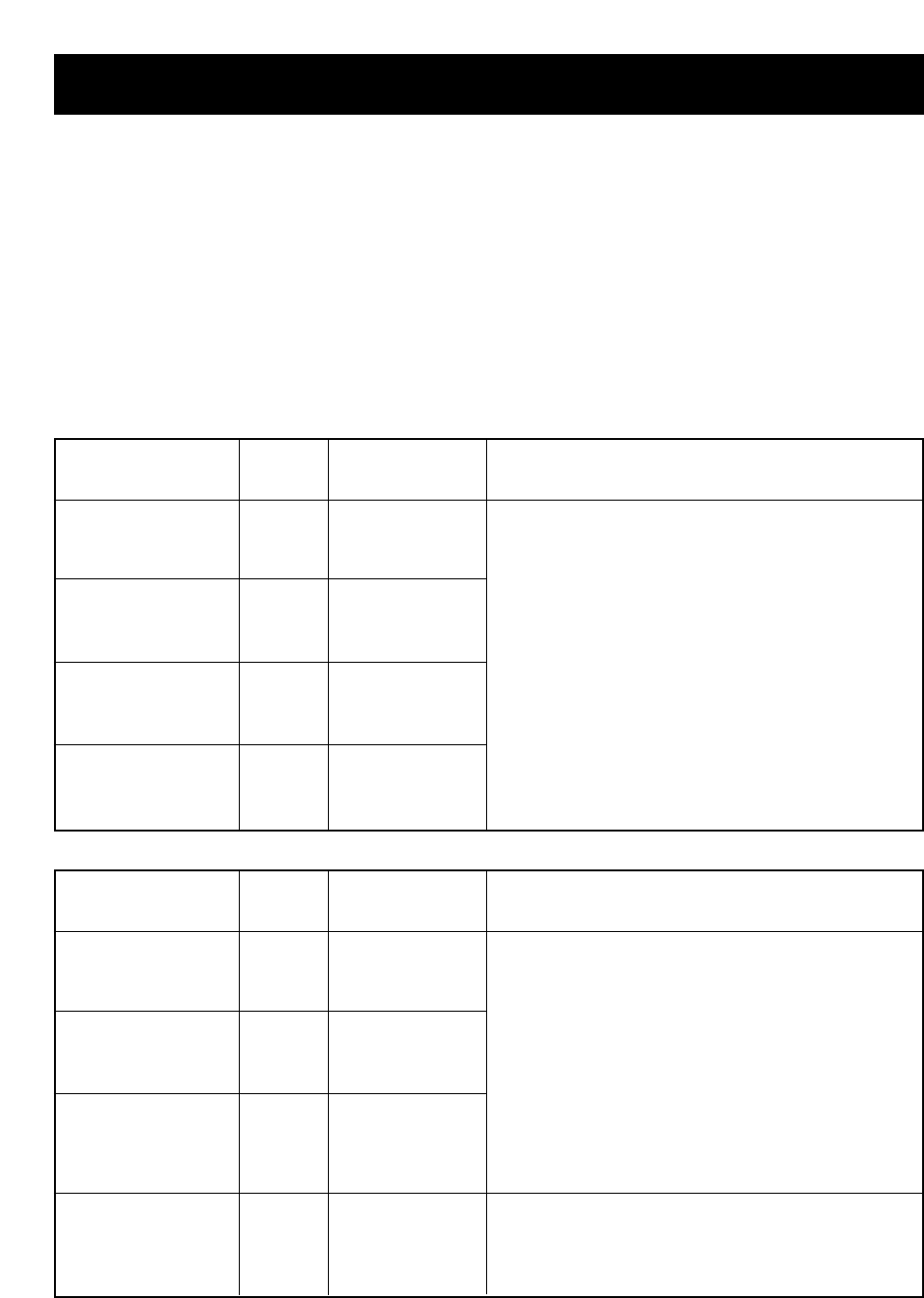
- 22 -
COOKING
Pasta And Rice
Microwave cooking and conventional cooking of pasta,
rice, and cereal require about the same amount of time,
but the microwave is a more convenient method
because you can cook and serve in the same dish.
There is no stirring needed and leftover pasta tastes
just like fresh cooked when reheated in the microwave
oven.
Cooking Pasta and Rice: Tips and Techniques
• If you are planning to use rice or pasta in a casserole,
undercook it so it is still firm.
• Allow for standing time with rice, but not for pasta.
• The Pasta and Rice Cooking Tables below provide
specific directions, with Power Level and cooking time
settings for most common types of pasta and rice.
Pasta Cooking Table
TYPE OF PASTA
Spaghetti
4 cups water Add
8 oz. spaghetti
Macaroni
3 cups water Add
2 cups macaroni
Lasagna noodles
4 cups water Add
8 oz. lasagna noodles
Egg noodles
6 cups water Add
4 cups noodles
HI
5
HI
5
HI
5
HI
5
10 to 11 minutes
8 to 9 minutes
7 to 8 minutes
6 to 7 minutes
8 to 9 minutes
12 to 13 minutes
9 to 11 minutes
6 to 7 minutes
Combine hot tap water and salt, if desired. Use a
2-quart microwavable baking dish and cover with
vented plastic wrap for spaghetti and lasagna
noodles. Use microwavable lid or vented plastic wrap
for macaroni and egg noodles.
Cook at Power Level HI as directed in chart or until
water boils. Stir in pasta; cook covered at Power
Level 5 as directed in chart or until tender.
Drain in a colander.
POWER
LEVEL
COOKING
TIME DIRECTIONS
Rice Cooking Table
Long grain
2 1/4 cups water Add
1 cup rice
Brown
2 1/2 cups water Add
1 cup rice
Long grain and
wild rice mix
2 1/3 cups water Add
6 oz. pkg.
Quick cooking
1 cup water Add
1 cup rice
HI
5
HI
5
HI
5
HI
5 to 6 minutes
15 minutes
5 to 6 minutes
30 minutes
41/2 to 51/2 minutes
25 minutes
2 to 3 minutes
Combine hot tap water and salt, if desired, in 2 quart
microwavable casserole. Cover with microwavable lid
or vented plastic wrap. Cook as directed in chart at
Power Level HI or until water boils. Stir in rice and any
seasonings.
Cook covered as directed in chart at Power Level 5
or until water is absorbed and rice is tender.
Let stand covered 5 to 10 minutes. Fluff with fork.
Cook water until it boils. Stir rice into boiling water and
let stand, covered 5 to 10 minutes or until water is
absorbed and rice is tender. Fluff with fork.
POWER
LEVEL
COOKING
TIME DIRECTIONS
TYPE OF RICE
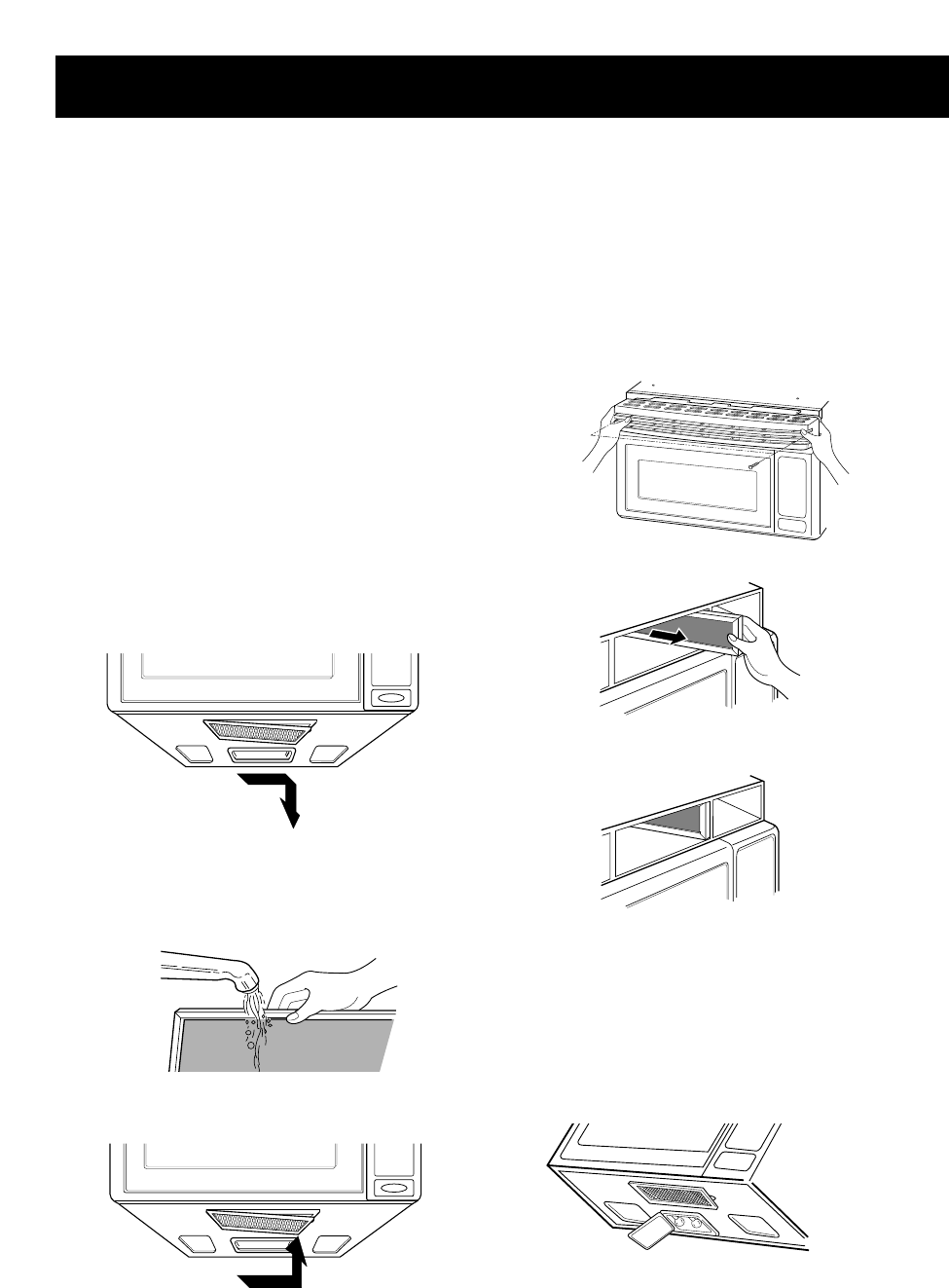
- 23 -
MAINTENANCE
CARE AND CLEANING
For best performance and safety, keep the oven clean
inside and outside. Take special care to keep the inner
door panel and the oven front frame free of food or
grease build-up.
Never use rough powder or pads. Wipe the
microwave oven inside and out, including the hood
bottom cover, with a soft cloth and a warm (not hot)
mild detergent solution. Then rinse and wipe dry.
Use a chrome cleaner and polish on chrome, metal, and
aluminum surfaces. Wipe spatters immediately with a
wet paper towel, especially after cooking chicken or
bacon. Clean your oven weekly or more often, if needed.
CLEANING THE GREASE FILTERS
The grease filters should be removed and cleaned
often, at least once a month.
1. To remove grease filters, slide each filter to the side.
Pull filters downward and push to the other side.
The filter will drop out.
WARNING - Disconnect power supply before replacing parts or cleaning. Do not let water or
detergent in unit, they may result in electrical shock hazard or electrical trouble on unit.
2. Soak grease filters in hot water and a mild
detergent. Rinse well and shake to dry.
Do not use ammonia or place in a dishwasher.
The aluminum will darken.
NOTE: Do not operate the hood without the filters in place.
3. To reinstall the filters, slide it into the side slot, then
push up and toward oven center to lock.
CHARCOAL FILTER REPLACEMENT
If your oven is vented inside, the charcoal filter should
be replaced every 6 to 12 months, and more often if
necessary. The charcoal filter cannot be cleaned.
To order a new charcoal filter, contact your dealers
parts department.
1. Remove the two vent grille mounting screws.
(2 middle screws)
5. Slide the top of the vent cover into place. Push the
bottom until it snaps into place. Replace the
mounting screws. Turn the power back on at the
main power supply and set the clock.
4. Slide a new charcoal filter into place.
The filter should rest at the angle shown.
2. Tip the grille forward, then lift it out
3. Remove old filter.
COOKTOP LIGHT REPLACEMENT
1, Unplug the oven or turn off power at the main power
supply.
2. Remove the bulb cover mounting screws.
3. Replace bulb(s) with 30 watt appliance bulb(s).
4. Replace bulb cover.
5. Turn the power back on at the main power supply.

- 24 -
USE
OVENPROOF GLASS (treated for high
intensity heat):
utility dishes, loaf dishes, pie plates,
cake plates, liquid measuring cups,
casseroles and bowls without metallic
trim.
CHINA:
bowls, cups, serving plates and platters
without metallic trim.
PLASTIC:
Plastic wrap (as a cover)-- lay the plastic
wrap loosely over the dish and press it to
the sides.
Vent plastic wrap by turning back one
edge slightly to allow excess steam to
escape. The dish should be deep
enough so that the plastic wrap will not
touch the food. As the food heats it may
melt the plastic wrap wherever the wrap
touches the food.
Use plastic dishes, cups,
semirigid freezer containers and plastic
bags only for short cooking time. Use
these with care because the plastic
may soften from the heat of the food.
PAPER:
Paper towels, waxed paper, paper
napkins, and paper plates with no
metallic trim or design. Look for the
manufacturer's label for use in the
microwave oven.
DO NOT USE
METAL UTENSILS:
Metal shields the food from microwave energy and produces
uneven cooking. Also avoid metal skewers, thermometers or foil
trays. Metal utensils can cause arcing, which can damage your
microwave oven.
METAL DECORATION:
Metal-trimmed or metal-banded dinnerware, casserole dishes,
etc. The metal trim interferes with normal cooking and may
damage the oven.
ALUMINUM FOIL:
Avoid large sheets of aluminum foil because they hinder cooking
and may cause harmful arcing. Use small pieces of foil to shield
poultry legs and wings. Keep ALL aluminum foil at least 1 inch
from the side walls and door of the oven.
WOOD:
Wooden bowls and boards will dry out and may split or crack
when you use them in the microwave oven. Baskets react in the
same way.
TIGHTLY COVERED UTENSILS:
Be sure to leave openings for steam to escape from covered
utensils. Pierce plastic pouches of vegetables or other food items
before cooking. Tightly closed pouches could explode.
BROWN PAPER:
Avoid using brown paper bags.
They absorb too much heat and could burn.
FLAWED OR CHIPPED UTENSILS:
Any utensil that is cracked, flawed, or chipped may break in the
oven.
METAL TWIST TIES:
Remove metal twist ties from plastic or paper bags.
They become hot and could cause a fire.
MICROWAVE UTENSIL GUIDE
MAINTENANCE

- 25 -
QUESTIONS AND ANSWERS
Q. Can I use a rack in my microwave oven so that
I may reheat or cook in two levels at a time?
A. Only use the rack that is supplied with your
microwave oven. Use of any other rack can result in
poor cooking performance and/or arcing and may
damage your oven.
Q. Can I use either metal or aluminum pans in my
microwave oven?
A. Usable metal includes aluminum foil for shielding
(use small, flat pieces), and shallow foil trays (if tray
is 3/4 inch deep and filled with food to absorb
microwave energy). Never allow metal to touch walls
or door.
Q. Sometimes the door of my microwave oven
appears wavy. Is this normal?
A. This appearance is normal and does not affect the
operation of your oven.
Q. What are the humming noises that I hear when
my microwave oven is operating?
A. You hear the sound of the transformer when the
magnetron tube cycles on and off.
Q. Why does the dish become hot when I
microwave food in it? I thought that this should
not happen.
A. As the food becomes hot it will conduct the heat to
the dish. Use hot pads to remove food after cooking.
Q. What does standing time mean?
A. Standing time means that food should be taken out
of the oven and covered for additional time after
cooking. This process allows the cooking to finish,
saves energy, and frees the oven for other purpose.
Q. Can I pop popcorn in my microwave oven?
How do I get the best results?
A. Yes. Pop packaged microwave popcorn following
manufacturer’s guidelines or use the
preprogrammed Popcorn pad.
Do not use regular paper bags. Use the listening test
by stopping the oven as soon as the popping slows
to a pop every one or two seconds. Do not try to
repop unpopped kernels. You can also use special
microwave poppers. When using a popper, be sure
to follow manufacturer’s directions. Do not pop
popcorn in glass utensils.
Q. Why does steam come out of the air exhaust
vent?
A. Steam is normally produced during cooking. The
microwave oven has been designed to vent this
steam out the top vent.
BEFORE CALLING FOR SERVICE
Check the following list to be sure a service call is really
necessary. A quick reference of this manual as well as
reviewing additional information on items to check may
prevent an unneeded service call.
If nothing on the oven operates:
• check for a blown circuit fuse or a tripped main circuit
breaker.
• check if oven is properly connected to electric circuit
in house.
• check that controls are set properly.
If the oven interior light does not works:
• the light bulb is loose or defective.
If oven will not cook:
• check that control panel was programmed correctly.
• check that door is firmly closed.
• check that Start Pad was touched.
• check that probe was inserted correctly
into receptacle.
• check that timer wasn’t started instead of a cook
function.
If oven takes longer than normal to cook or cooks
too rapidly:
• be sure the Power Level is programmed properly.
If the time of day clock does not always keep
correct time:
• check that the power cord is fully inserted into the
outlet receptacle.
• be sure the oven is the only appliance on the
electrical circuit.
If food cooks unevenly:
• be sure food is evenly shaped.
• be sure food is completely defrosted before cooking.
• check placement of aluminum foil strips used to
prevent overcooking.
If food is undercooked:
• check recipe to be sure all directions (amount, time, &
power levels) were correctly followed.
• be sure microwave oven is on a separate circuit.
• be sure food is completely defrosted before cooking.
If food is overcooked:
• check recipe to be sure all directions (amount, power
level, time, size of dish) were followed.
If arcing (sparks) occur:
• be sure microwavable dishes were used.
• be sure wire twist ties weren’t used.
• be sure oven wasn’t operated when empty.
• make sure metal rack (if used) is properly installed on
4 supports.
If the Display shows a time counting down but the
oven is not cooking:
• check that door is firmly closed.
• check that timer wasn’t started instead of a cooking
function.
TROUBLE SHOOTING

- 26 -
MEMO

- 27 -
MEMO

Limited Warranty
For Dometic Microwave Models DOTR12CW, DOTR12CB
THE SELLER NAMED BELOW MAKES THE FOLLOWING WARRANTY
WITH RESPECT TO THIS DOMETIC MICROWAVE OVEN.
1. This Warranty is made only to the first Purchaser (hereinafter called the "Original Purchaser") who acquires
this product for his own use.
2. This Warranty will be in effect for one year from the date of purchase by the Original Purchaser. It is
suggested that the Original Purchaser retain a copy of the dated bill of sale as evidence of the date of
purchase.
3. This Warranty covers only specified parts which shall be free from defects in material and workmanship
under normal use. This Warranty does not cover conditions unrelated to the material and workmanship of
the product. Such unrelated conditions include, but are not limited to (a) faulty installation and any damage
resulting from such; (b) the need for normal maintenance and any damage resulting from the failure to
provide such maintenance; (c) failure to follow Seller's instructions for use of the product, and (d) any
accident to, or misuse of any part of this product and any alteration by anyone other than Seller or the
authorized representative.
4. In order to obtain the benefits of this Warranty, you should return the product which you find defective to
your dealer during the period that this Warranty is in effect. All charges incurred in delivery of the microwave
to Seller must be paid by the Original Purchaser. A copy of the dated bill of sale must accompany the
returned microwave oven.
5. Any item returned in the manner described in paragraph 4 will be examined by your dealer. If it is found that
the microwave is defective in material and workmanship, the Seller will replace the appliance.
6. The Seller does not authorize any person or company to create any warranty obligation or liability on their
behalf.
7. IN NO EVENT SHALL SELLER BE LIABLE FOR INCIDENTAL OR CONSEQUENTIAL DAMAGES, SOME
STATES DO NOT ALLOW THE EXCLUSION OR IMITATION OF INCIDENTAL OR CONSEQUENTIAL
DAMAGES SO THE ABOVE LIMITATION MAY NOT APPLY TO YOU.
8. ANY IMPLIED WARRANTY, INCLUDING THE IMPLIED WARRANTY OF MERCHANTABILITY AND
FITNESS FOR ANY PURPOSE, IS LIMITED TO THE DURATION OF THIS LIMITED WARRANTY, SOME
STATES DO NOT ALLOW LIMITATIONS ON HOW LONG AN IMPLIED WARRANTY LASTS, SO THE
ABOVE LIMITATION MAY NOT APPLY TO YOU.
9. THIS WARRANTY GIVES YOU SPECIFIC LEGAL RIGHTS, AND YOU MAY ALSO HAVE OTHER
RIGHTS WHICH VARY FROM STATE TO STATE.
10. All appliances (except those specifically built for commercial use) are warranted only when installed in
vehicles built to the R.V.I.A. and CSA Standards.
Seller in USA Seller in CANADA
The Dometic Corporation The Dometic Corporation
The Warranty Department The Warranty Department
509 South Poplar Street 866 Langs Drive
LaGrange, Indiana 46761 Cambridge, Ontario
Canada N3H 2N7